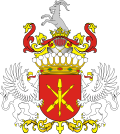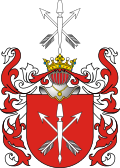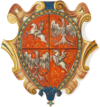Jelita coat of arms
| Jelita | |
|---|---|
 | |
| Battle cry | Jelita, Nagody |
| Alternative name(s) | Hastae, Jelito, Koźlarogi, Koźle Rogi, Tres Hastae |
| Earliest mention | 1316 (seal) |
| Families | 551 names |
| Cities | Dyneburg (1582–1772), Kraśnik, Tomaszów Lubelski, Józefów Biłgorajski, Zamość, Zwierzyniec |
| Gminas | Gmina Dłutów, Gmina Jadów, Gmina Moszczenica, Gmina Morawica, Gmina Tereszpol |
Jelita is a Polish coat of arms. It was used by several szlachta families.
History
[edit]One of the oldest Polish coats of arms. First depicted on the seal of Tomisław z Mokrska from 1316.
Additionally, the Polish medieval chronicler, diplomat and soldier Jan Długosz referred to those bearing the Jelita coat of arms as "a clan born in Poland of men who are modestly devoted to dogs and hunting."
Legend
[edit]Legend has it that this coat of arms was granted by King Władysław I Łokietek to a peasant soldier (and his family) after the Battle of Płowce (1331) in which the Polish armies defeated the 40,000-strong force of the Teutonic Knights with minimal casualties. The man fought with great courage and only fell in battle when pierced by three spears in the abdominal area which caused his bowels to fall out. Shortly before his death, the King ennobled the fatally wounded man. Hence, the three crossed spears in the coat of arms, as well as the name Jelita, Bowels or Guts.
Blazon
[edit]There are three lances of gold (or yellow), displayed in the design of a star on a red field, so that two on the sides are shown with their ends and points upward and the center lance with its point straight downward. on the helmet is a demi goat leaping with its forepaws upward, facing to the right, with horns on its head. The goat on top is the symbol of persistence, practical wisdom and an emblem of a man who wins through diplomacy rather than war.[1] It may also refer to the goat crest of Lublin. The Act of the Union of Lublin, signed in 1569, created the so-called Commonwealth of two Nations, under one monarch, with one parliament and unified monetary systems.[2]
The heraldic motto of this coat of arms is "To mniey boli" (It hurts less).[3]
This section is empty. You can help by adding to it. (July 2010) |
Notable bearers
[edit]Notable bearers of this coat of arms include:
- House of Zamoyski
- Florian Pacanowski
- Józef Śliwicki
- Ignacy Jan Paderewski
- Franciszek Dąbrowski
- Stefan Żeromski
- Witold Lutosławski
- Ryszard Kaczorowski
- Jacek Saryusz-Wolski
- Count Petr Mikhaïlovitch Korwin-Litwicki (1796-1856}, titular councillor of the Russian Empire [1]
Gallery
[edit]-
Coat of arms of Counts Zamoyski
-
Coat of arms of Counts Bielski
-
Gorłowski (odm.)
-
Hilchen (odm.)
-
Geometer (odm.)
-
Jelita III (odm.)
-
Koźlakowski (odm.)
-
Manikowski (odm.)
-
Maszalski (odm.)
-
Natalis (odm.)
-
Serny (odm.)
-
Sienicki (odm.)
-
Słowieński (odm.)
-
Szczerbic (odm.)
-
Szydłowski (odm.)
-
Wielkołucki (odm.)
See also
[edit]Bibliography
[edit]- Tadeusz Gajl: Herbarz polski od średniowiecza do XX wieku : ponad 4500 herbów szlacheckich 37 tysięcy nazwisk 55 tysięcy rodów. L&L, 2007. ISBN 978-83-60597-10-1.
- Alfred Znamierowski: Herbarz rodowy. Warszawa: Świat Książki, 2004, s. 112. ISBN 83-7391-166-9.
References
[edit]- ^ Zurek, Werner (2022-09-20). The noble Polish family Gawlowski. Die adlige polnische Familie Gawlowski (in German). BoD – Books on Demand. ISBN 978-3-7568-3531-7.
- ^ Frost, Robert (1995). The Oxford History of Poland-Lithuania: Volume I: The Making of the Polish-Lithuanian Union, 1385-1569 (Oxford History of Early Modern Europe). Oxford University Press.
- ^ "Muzeum Zamoyskich w Kozłówce". www.muzeumzamoyskich.pl. Retrieved 2023-01-03.
External links
[edit]- http://www.tchorznicki.com/herb_ojelitczykach.html Archived 2010-06-22 at the Wayback Machine

















